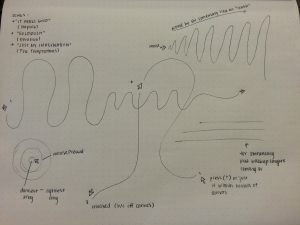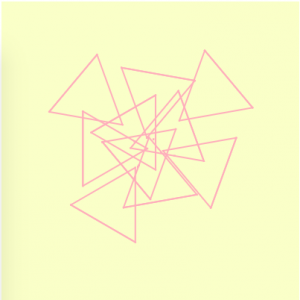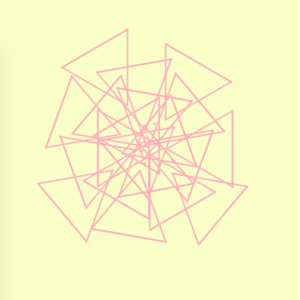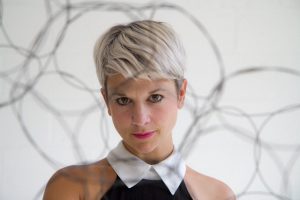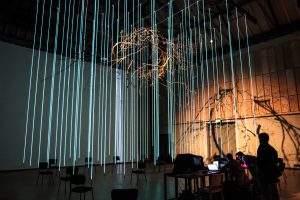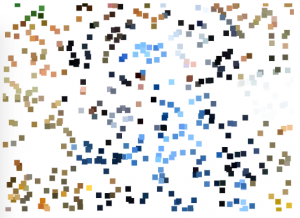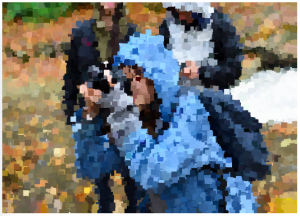Play this link in a separate tab before starting!
Press keys a, p, m, or y for different displays.
// Isabella Hong
// Section A
// ijhong@andrew.cmu.edu
// Final Project - AudioVisualMixer
//variables for color in RGB mode
var colorR = 255;
var colorG = 255;
var colorB = 255;
//variable used in function Beat
var s = 0;
//variable used for noise effect
var xoff = 0;
function setup() {
createCanvas(500, 500); //canvas size
}
function draw() {
background(0); //background color black
//create values for the rotation, offset, and diameter of "Ring"
var rotation = 45;
var offset = [50, 100, 150, 200, 250, 300];
var d = [40, 25, 10, 5, 3, 2];
//create continuous ring of ellipses
push();
translate(width / 2, height / 2);
for (var i = 0; i < 25; i ++) {
Ring(offset[0], 0, d[0]);
Ring(offset[1], 0, d[1]);
Ring(offset[2], 0, d[2]);
Ring(offset[3], 0, d[3]);
Ring(offset[4], 0, d[4]);
Ring(offset[5], 0, d[5]);
rotate(radians(rotation));
rotate(millis()/9500);
}
pop();
//various displays
Beat(100, 100);
Beat(400, 400);
Interject1();
Interject2();
Interject3();
}
//rotating ring (default display)
function Ring(x, y, d) {
//randomize colors of ellipses
colorR = random(200, 255);
colorG = random(100, 255);
colorB = random(100, 200);
noStroke();
colorMode(RGB);
fill(colorR, colorG, colorB);
ellipse(x, y, d, d);
}
//pulsing
function Beat(x, y, s) {
s = random(100, 200);
if (keyIsPressed) {
//press key p to display
if ((key == 'p')) {
noStroke();
//randomize size of ellipses in this range to create pusling effect
s = random(10, 110);
fill(206, 255, 255);
ellipse(x, y, s, s);
s = random(100, 200);
strokeWeight(5);
stroke(205, 0, 205);
noFill();
ellipse(x, y, s, s);
}
}
}
//oscillation
function Interject1() {
//noise
xoff += 0.015;
var n = noise(xoff) * width;
if (keyIsPressed) {
//press key m to display
if ((key == 'm')) {
noStroke();
//randomize color
colorR = random(155, 255);
colorG = random(155, 255);
colorB = random(155, 255);
//background
fill(colorR, colorG, colorB);
rect(0, 0, 1000, 1000);
//objects affected by noise
strokeWeight(10);
stroke(255);
noFill();
line(0, n, 100, n);
line(500, n, 400, n);
ellipse(250, 250, n, n);
}
}
}
//rotating bar
function Interject2() {
//press key y to display
if ((key == 'y')) {
noStroke();
fill(0);
rect(0, 0, 10000, 10000);
rotate(millis()/275);
//create the rectangles to rotate
for (var i = 0; i < 1000; i += 50) {
rectMode(CENTER);
noFill();
strokeWeight(10);
stroke(255, 255, 0);
rect(i, i, 100, 100)
stroke(255, 0, 255);
rect(i, i, 200, 200);
stroke(0, 255, 255);
rect(i, i, 300, 300);
strokeWeight(10);
stroke(255, 255, 0);
rect(i, i, 100, 100)
stroke(255, 0, 255);
rect(i, i, 200, 200);
stroke(0, 255, 255);
rect(i, i, 300, 300);
}
}
}
//shaky strings
function Interject3() {
//press key a to display
if ((key == 'a')) {
//randomize colors
colorR = random(100, 200);
colorG = random(200, 255);
colorB = random(200, 150);
//background
fill(colorR, colorG, colorB);
rect(0, 0, 1000, 1000);
//drawing strings
for (var a = 0; a < width; a += 10) {
stroke(255);
strokeWeight(1);
line(a, 400, width, a);
}
for (var b = 0; b < height; b += 10) {
stroke(255, 0, 255);
strokeWeight(1);
line(b, 400, height - 100, b);
}
for (var c = 0; c < width; c += 10) {
stroke(255);
strokeWeight(2);
line(c, 300, width - 640, c);
}
for (var d = 0; d < height; d += 5) {
stroke(0, 255, 255);
strokeWeight(1);
line(d, 100, height - 640, d);
}
}
}
For my final project, I created an interactive audio visual mixer using the song Shelter by Porter Robinson and Madeon. There are four different display settings that the user can choose from. Pressing the corresponding keys will load animations that correspond to parts of the song. There are three functions called “Interject” that display image oriented animations while the function “Beat” displays pulsing ellipses that coincide with the beats of the song.
The main issue I had was embedding the audio file and having it load properly so I opted to link the file instead of it having it play automatically.
Enjoy!
![[OLD – FALL 2016] 15-104 • COMPUTING for CREATIVE PRACTICE](../../wp-content/uploads/2020/08/stop-banner.png)
